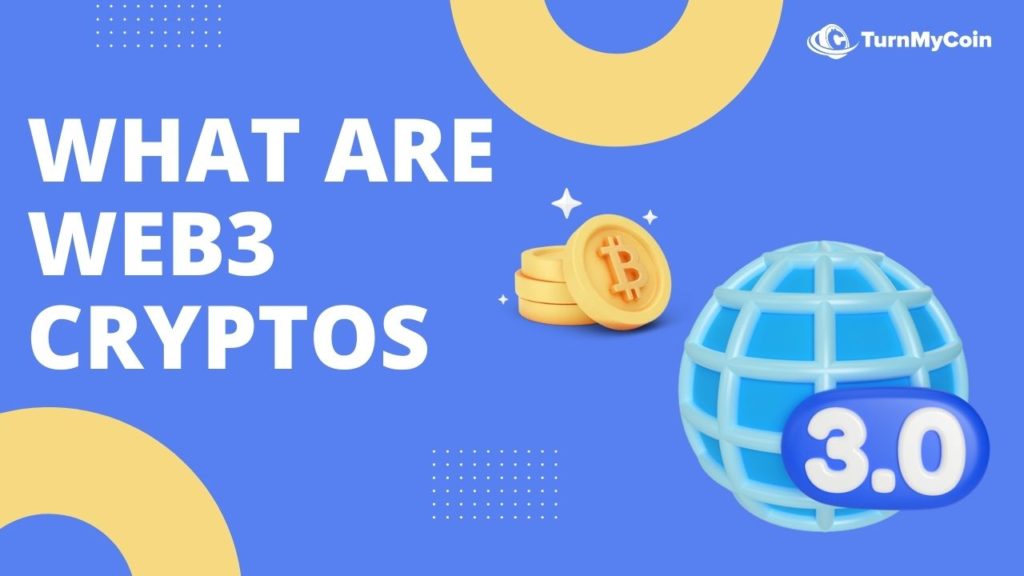Last updated on January 19th, 2024 at 06:46 am

Web3 cryptocurrencies represent the future iteration of digital currencies which operate on decentralized blockchain networks, providing users with the ability to interface with decentralized applications (dApps) and services. The underlying idea of these decentralized networks and Web3 cryptocurrencies traces back to the earliest days of Bitcoin and the blockchain technology that underpins it.
As individuals have grown more enamored with cryptocurrencies, they have also become more intrigued by secure systems that can safeguard user privacy and preclude censorship. This is where Web3 cryptocurrencies play a vital role. Diverging from their Web2 equivalents, Web3 cryptocurrencies are tailored to be more convenient, user-friendly, and interoperable, thereby enabling developers to craft an uninterrupted and secure online experience. With their emphasis on privacy, security, and self-sovereignty, Web3 cryptocurrencies harbor the potential to upend how we transact and communicate online. In this article, we will scrutinize the What are web3 cryptos ? advantages of Web3 cryptocurrencies and how they differ from conventional cryptocurrencies.
Table of Contents
What makes web3 cryptos different from traditional cryptocurrencies

Web3 cryptocurrencies diverge from traditional cryptocurrencies in various aspects. One of the salient differences is the emphasis on decentralization, wherein a central authority does not control the network. Instead, every participant has an equal voice in determining the network’s operation. Moreover, web3 cryptocurrencies utilize advanced blockchain technology, which is more secure and efficient than the technology employed in traditional cryptocurrencies.
Furthermore, they support intricate smart contracts that can automate complex transactions and cater to diverse purposes compared to traditional cryptocurrencies. Another fundamental difference is the ability of web3 cryptocurrencies to enable the development of decentralized applications (dApps), which serve various functions such as gaming, finance, and social media without central authority influence. Lastly, web3 cryptocurrencies employ a proof-of-stake consensus mechanism that requires less energy than the proof-of-work mechanism used by traditional cryptocurrencies, which makes them more eco-friendly.
Web3 cryptocurrencies demonstrate a departure from traditional cryptocurrencies due to their decentralized nature, providing every participant with equal power in network governance. The advanced blockchain technology employed in web3 cryptocurrencies delivers superior security and speed compared to traditional cryptocurrencies. Furthermore, web3 cryptocurrencies’ smart contracts can execute intricate transactions, accommodating a broader range of applications. Additionally, web3 cryptocurrencies allow for the creation of dApps, which provide new opportunities for gaming, finance, and social media without central authority control. Lastly, web3 cryptocurrencies’ use of a proof-of-stake consensus mechanism distinguishes them from traditional cryptocurrencies by being more energy-efficient.
Examples of popular web3 cryptos

Web 3, which is also referred to as the decentralized web, is an emergent technology that seeks to transform the internet by providing a more impregnable, translucent, and censorship-resistant network. One of the primary components of Web 3 is cryptocurrencies that operate on decentralized blockchain networks. Presented here are a few illustrations of well-received Web 3 cryptocurrencies.
Ethereum (ETH)
Ethereum is the second largest cryptocurrency by market capitalization and the most prevalent platform for decentralized applications (dApps). It grants developers the ability to construct smart contracts, which are self-executing agreements that operate on the blockchain. Ethereum also pioneered the concept of non-fungible tokens (NFTs), which enable digital assets such as art, music, and collectibles to be recognized as unique and traded on the blockchain.
Polkadot (DOT)
Polkadot is a cutting-edge blockchain platform that endeavors to furnish a scalable and interoperable network for decentralized applications. It utilizes a multi-chain framework that authorizes different blockchain networks to interconnect with each other, thus enabling a more connected and seamless ecosystem.
Chainlink (LINK)
Chainlink is a decentralized oracle network. It connects smart contracts with real-world data and events. It enables developers to construct dApps that can interact with external data sources in a secure and trustless fashion, opening up a plethora of opportunities for decentralized finance (DeFi) and other Web 3 applications.
How web3 cryptos are being used

Web3 cryptocurrencies, also known as decentralized digital currencies, have been harnessed in various ways in the contemporary digital milieu. Below are a few examples of how Web3 cryptos have been implemented:
Decentralized finance
The burgeoning decentralized finance (DeFi) industry has adopted Web3 cryptos in its operations. DeFi enables users to access traditional financial services, like lending and borrowing, without relying on centralized institutions such as banks. Ethereum and its associated tokens, as Web3 cryptos, are utilized as the underlying currency for different DeFi protocols.
Non- fungible tokens ( NFTS)
Web3 cryptos are utilized in procuring, selling, and exchanging non-fungible tokens (NFTs), which are exceptional digital assets that are validated on the blockchain. NFTs have gained popularity in the art and gaming sectors, where they represent ownership of digital artwork, in-game items, and other digital assets.
Decentralized applications
Decentralized applications (dApps), which operate on a blockchain and are not governed by a single entity, also utilize Web3 cryptos. It serve as the payment mechanism for various dApps, including social media platforms, marketplaces, and gaming applications.
Online transactions
Web3 cryptos are employed in online transactions, particularly for products and services that are not widely accessible or that cannot be easily acquired using traditional payment methods. It provide a secure and transparent means of purchasing online without the need for intermediaries such as banks or payment processors.
Advantages and Disadvantages
Digital currencies have existed for more than a decade, but the emergence of Web3 technologies has led to their decentralization and increased security. However, like any other technological innovation, Web3 cryptocurrencies have their own strengths and weaknesses. This part of article aims to highlight advantage and disadvantage of web 3.
Advantages

Decentralization: Web3 cryptos are decentralized, rendering them impervious to control by any central entity or authority. This feature contributes to their security and makes them resistant to fraud and hacking attempts.
Anonymity: Transactions executed with it are anonymous, making them the preferred option for those who cherish privacy and confidentiality.
Faster Transactions: Transactions made with it are faster when compared to traditional banking systems because they do not require intermediaries to execute the transaction.
Lower Transaction Fees: They have lower transaction fees compared to traditional banking systems, making them a more economical choice.
Accessibility: It can be accessed from anywhere in the world, as long as there is an internet connection, making them a convenient option for those who require cross-border transactions.
Disadvantages
Volatility: The value of Web3 cryptos can be highly volatile, making them a risky investment option for individuals.
Limited Acceptance: They are not yet universally accepted as a form of payment, which restricts their use.
Lack of Regulation: The lack of regulation in the Web3 crypto market makes it difficult to protect investors and consumers from fraud and scams.
Environmental Impact: The mining process of it requires a significant amount of energy, and this has an adverse effect on the environment.
Complexity: The use of Web3 cryptos necessitates technical knowledge, which can act as a barrier for some users who lack the technical know-how.
Predictions for the future:

As web3 technology garners greater recognition from both developers and corporations. We are set to witness a remarkable surge in the adoption of web3 cryptocurrencies across diverse industries. It appears as though web3 has become the new trendsetter, and everyone is striving to establish a rapport with it.
However, it is not just about being in vogue, you comprehend? The fact of the matter is that web3 cryptocurrencies are bound to be employed in real-world applications such as supply chain management, voting systems, and even social media platforms! Consequently, we can anticipate witnessing web3 integration taking our favorite social media applications to a whole new level of excellence.
And here is the thing, as decentralized applications (DApps) become increasingly dynamic and efficient. The growth of web3 cryptocurrencies will skyrocket. In a sense, it is like DApps are the festivity, and web3 cryptocurrencies are the DJ playing the most popular tracks.
Oh, and let us not overlook scalability. With the advent of layer 2 solutions and other cutting-edge scalability innovations. Web3 cryptocurrencies will be capable of addressing the challenges that have hindered their proliferation in the past. It is almost as if web3 cryptocurrencies are finally poised to hit their stride and achieve colossal success.
Therefore, get set, people, as web3 is on the verge of becoming a global sensation.
Challenges to widespread adoption:
The acceptance of new technology and innovation is regularly impeded by several obstacles. A predicament that remains true for emerging technologies like blockchain, virtual reality, and artificial intelligence. The following are some of the issues that hinder the widespread adoption of these technologies:
Technology
Firstly, cost represents one of the principal hurdles for the widespread adoption of innovative technology. Numerous emerging technologies necessitate significant investment in development. Implementation, and maintenance, constituting a significant barrier for smaller organizations and individuals lacking the resources to invest in such technologies.
Technical expertise
Secondly, the lack of technical expertise required to employ and implement emerging technologies is another issue. This predicament presents a particular challenge for individuals or organizations in industries where the use of technology is not yet widespread.
Security
Thirdly, concerns regarding security and privacy pose a significant challenge to the widespread adoption of emerging technologies. Individuals and organizations have become more wary of adopting new technologies that might compromise their sensitive data.
Regulations
Fourthly, regulations and legal frameworks concerning emerging technologies present a challenge. Numerous technologies are still in their infancy, and there may be a dearth of clear guidelines and laws governing their use.
Adaptability
Lastly, resistance to change represents another challenge to the widespread adoption of emerging technologies. Individuals and organizations might be hesitant to embrace new technologies. Due to the fear of the unknown or a reluctance to abandon established practices.
Conclusion
If you’re a crypto enthusiast, you might wanna hear about this new buzz in town. Brace yourself for the mighty Web3 cryptos. They’re like a level-up from traditional cryptocurrencies, with more bells and whistles to offer. Not only that, but they’re also pretty useful in a wide range of situations.
So, what makes these Web3 cryptos stand out? It’s all thanks to the magic of blockchain technology, which gives them that extra oomph of decentralization, security, and transparency. That’s why folks are going crazy about them in the decentralized finance and non-fungible token markets. But hold your horses, there are some challenges to overcome, like the whole scalability and energy consumption thingy.
But don’t you worry, my friend. The future of Web3 cryptos looks super bright, with a potential to revolutionize various industries. As blockchain technology keeps getting better and better. So , we can expect to see some crazy advancements in the capabilities and applications of Web3 cryptos. Plus, more and more people are using them in mainstream markets, which is a good sign that they’re not going anywhere anytime soon.
At the end of the day, the success of Web3 cryptos will depend on how well they can solve real-world problems and offer tangible value to their users. And who knows, maybe one day, you might even use them to buy your very own jetpack! (Okay, maybe not yet, but we can dream, can’t we?)